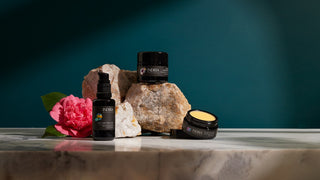As we journey through life, our skin tells a story. For many of us, that story includes chapters on hyperpigmentation - those pesky dark spots that can appear on our skin, creating an uneven skin tone. But fear not, dear reader!
Today, we're diving into the world of skin pigmentation and exploring how to reduce hyperpigmentation effectively.
Understanding Hyperpigmentation
Hyperpigmentation is a common skin condition that occurs when certain areas of the skin produce more melanin than usual. Melanin is the natural pigment that gives our skin, eyes, and hair their colour. While it provides a naturally mild form of sun protection by absorbing harmful UV rays, an overproduction can lead to darker patches on the skin.
Interestingly, as skin ages, its ability to produce melanin typically reduces; however, existing sites of pigmentation tend to increase in size and intensity.
What Causes Hyperpigmentation?
Several factors can trigger excess melanin production:
-
Sun Exposure: The most common culprit, especially in sunny climates like Queensland.
-
Hormonal Changes: It should be noted that sometimes pigmentation can also occur due to hormonal changes (known as melasma)—often during pregnancy when the female sex hormones oestrogen and progesterone stimulate the overproduction of melanin.
-
Post-Inflammatory Hyperpigmentation: This can occur after skin trauma, such as acne or injuries.
-
Aging: As we age, existing pigmentation tends to increase in size and intensity.
It's worth noting that darker skin types are more prone to hyperpigmentation due to their naturally higher melanin content.
How to Reduce Hyperpigmentation
So now that you are equipped with the what and cause, and perhaps are, in fact, experiencing hyperpigmentation yourself, the next question is how does one treat pigmentation?
While there are various treatments available, from lasers to chemical peels, it's often best to start with gentler, natural approaches. Here's a step-by-step guide to help you manage and treat pigmentation:
Step 1: Exfoliate Regularly
Start with regular use of our highly effective Exfoliating Cream every second or third day to gently buff away the outer layer of the epidermis (known as the stratum corneum) to help even skin tone and allow for more effective penetration of carefully chosen follow-in products. As an aside, noting the skin naturally slows its exfoliating abilities as we age, our Exfoliating Cream is a truly great secret weapon in helping to maintain smooth skin.
Step 2: Incorporate Active Ingredients
Add active ingredients such as vitamin C and vitamin A into your skincare routine to help fade and repair the skin. We recommend two of our own products for this purpose:
-
Our Pigmentation Serum contains a blend of active botanical ingredients that are clinically proven to reduce pigmentation by 28% over a period of 30 days. This gorgeous product is delightful to use, rich in Vitamin C from native Kakadu Plum, a base of healing aloe vera, and incorporating a carefully formulated array of varying molecular weighted hyaluronic acid that allow actives to penetrate the epidermis at varying depths, our Pigmentation Serum provides a brilliant everyday option that can bring about a noticeable improvement to help reduce skin pigmentation. We recommend this product for day use beneath your moisturiser.
-
Our Repair Oil, which targets the repair of damaged skin, incorporates Vitamin A from Carrot Seed Oil or our brand new Age-Defying Oil, which has 1% of a potent quality bakuchiol, which is rich in Vitamin A to encourage cell renewal. We recommend these products for use at night before you sleep.
Step 3: Lock in Moisture
Layer with a high-quality moisturiser to seal in your treatments. Choose between our Revitalising Moisturiser for daily use or the richer Renew Moisturiser for extra hydration.
Step 4: Sun Protection is Key
Possibly the most crucial step: protect your skin from further sun damage. Always apply a broad-spectrum sunscreen with a high SPF approved by the Therapeutic Goods of Australia (TGA). This prevents further pigmentation and allows existing dark spots to fade naturally over time.
Our Tips for Managing Hyperpigmentation
-
Be Patient: When you treat hyperpigmentation, it takes time. Consistency is key!
-
Gentle is Best: Avoid harsh treatments that irritate skin quality and potentially worsen pigmentation.
-
Consider Professional Help: If you're unsure about your skin condition, consult a dermatologist for personalised advice and potentially clinical skin treatments.
-
Embrace Natural Ingredients: Look for skincare products with alpha hydroxy acids (AHAs) and other natural brightening agents. Our products include a fusion of nourishing remedial ingredients and potent natural active botanicals (that deliver visible results).
Remember, while hyperpigmentation can be frustrating, it's usually harmless. With the right care and products, you can achieve a more even skin tone and boost your confidence.
Discover Your Best Skin Naturally
At Indira Organics, we believe in formulations that work synergistically with your skin to deliver exceptional results. Our range of organic skincare products harness powerful native botanicals and other active ingredients backed by science, helping you to manage hyperpigmentation and achieve visible skin results. Here's to effortlessly embracing your natural beauty!



